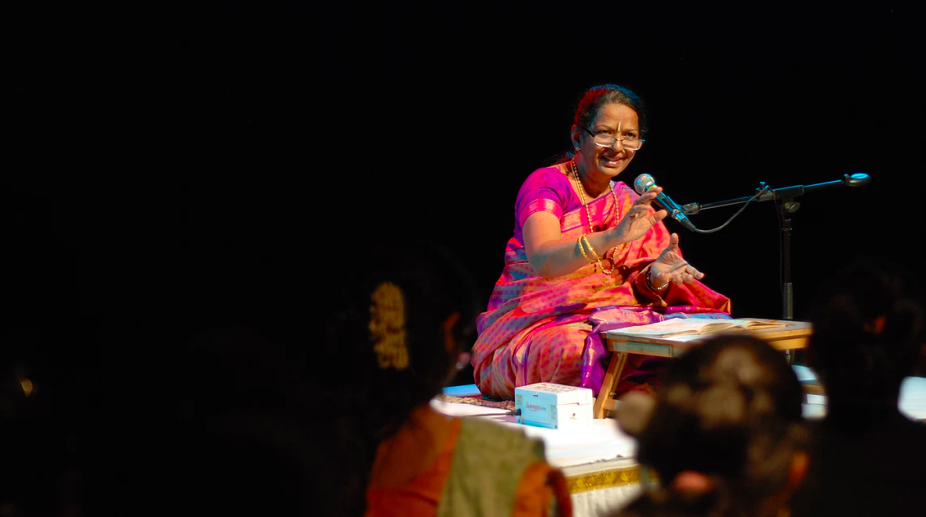It was indeed a rare honour to have had an opportunity to chat with a learned Sanskrit scholar, Prof T S Satyavathi, who is also a proficient Carnatic vocalist. She has spent her life delving into forgotten Sanskrit treatises, translating them, editing others’ works ~ indeed scholarly work of an unmatched value for future generations. She expounds on her subject with the clarity of a master; abstract terms and concepts sound so easy from her! Excerpts:
Please tell us about the subject of your doctorate.
I chose the ‘Manasulhaasa’, a12th century encyclopedia on music with 100 chapters, in two volumes. There are only three copies of this text available. I have translated the chapters on music into Kannada too.
Advertisement
It refers to itself as ‘Jagatacharya pustakam’ (world’s learned text). Someswara the third, a Chalukyan king, himself wrote it. Many later writers refer to him, as his work is regarded as having great practical relevance; even Tygaraja refers to him. He ascended the throne when he was 40 and the time before was spent on amassing knowledge.
In his treatise, I dealt with the three chapters that deal with the 64 arts. He makes the point that 50 Ragas are actually in wide use at a time, so he gives details of those; today many of the Ragas have changed structures even though the names are the same. The work lists several compositions, different talas, murchana, prabandh (composition), prabandh dosh (defects in enunciation of compositions), vrinda gaan (chorus music) and seven types of gamakas.
The work also describes all extant instruments, how they were constructed, how to hold them and play them. Vocalists’ posture, how to sing, audience tastes and much more is dealt with. One particularly interesting description relates to an actual concert held in his court ~ it describes exactly where the male singer sits, where the female singer sits, the Mridangam, the flautist ~ interestingly, there is no Veena acompanyist ~ who sits to the left of the musicians, who at the right, front and who sits behind.
The text says music is not for entertainment, and amusement, but for education. It took me seven long years to do my Phd on just this one text!
Why are you not translating more works on music in Sanskrit? Are there not many which are still not translated?
There are so many, literally hundreds. The first, the Natya Shastra, a 2nd century AD work has six chapters out of 36 on music. Brihadheshi’s work, a 7th century AD work, talks of parent Ragas, their offsprings, their note structures and so on. Once the Sangeeta Ratnakar by Sarangdeva came into the picture, all other Sanskrit texts receeded into the background. They were forgotten. Though, in fact, I feel Sangeeta Ratnakar is not as practical today as Someswara’s work; yes it is very comprehensive and 380 Ragas are written about but not even one is relevant today! My point is, the relevance of what these texts say on the subject of Ragas is limited as the Ragas have changed over the centuries. So what an ancient text is saying on the shape or note structure of a Raga, even if the name of the Raga is the same today, is not valid; as the notes have changed!
People at large have lost interest in Sanskrit, because you are not able to relate the contents to today. The texts are not clear, there are corruptions, you cannot make out whether it’s this word or another, one has to literally deconstruct the text!! I have struggled so much just with one text.
What are you working on now?
Today, my subject of interest is time in music. I feel this is worth researching into, as it has practical relevance today. Time plays a very important role in the presentation of music. The amount of time you pause between notes can completely change the feel of the Raga. A Raga is identified by its note structure, which is to be sung within an optimum time frame. Yes, of course, it’s a subjective thing, but still the rules matter. Which note to start on is just one aspect of Raga presentation.
The concept of time in ‘Anibadh’ (without tala constraints) sangeet is even more important, but is relevant even in Nibadh (composed) sangeet. Time plays a very important role; a composition that is to be rendered at a particular speed, must be only at that speed, neither faster nor slower. If you don’t sing it within the correct time frame, if you stretch it too much it becomes a different Raga, or it loses its impact. If you sing it too fast, or even too slow, you are losing the essence of the composition, in fact, the very essence, the colours of the swara (note).
A particular speed of articulation will be particular to a singer; it’s like a ‘bani’. Speed or time marks the style of a singer too. How long you are singing in the higher octave, how long in the lower octave ~ music is so linked with the concept of time!
In music, the combination of speeds is very relevant; speed itself means time. The combination of drut, madhya and vilambha (fast medium and slow tempo) ~ how you combine these speeds when you articulate a cluster of notes, one sanchar. How long should this take? This was the subject of my lecture at the Madras Music Academy on 26 December, when I was honoured by the Academy as well.
The writer specialises in music, musicians and matters musical).
Advertisement











